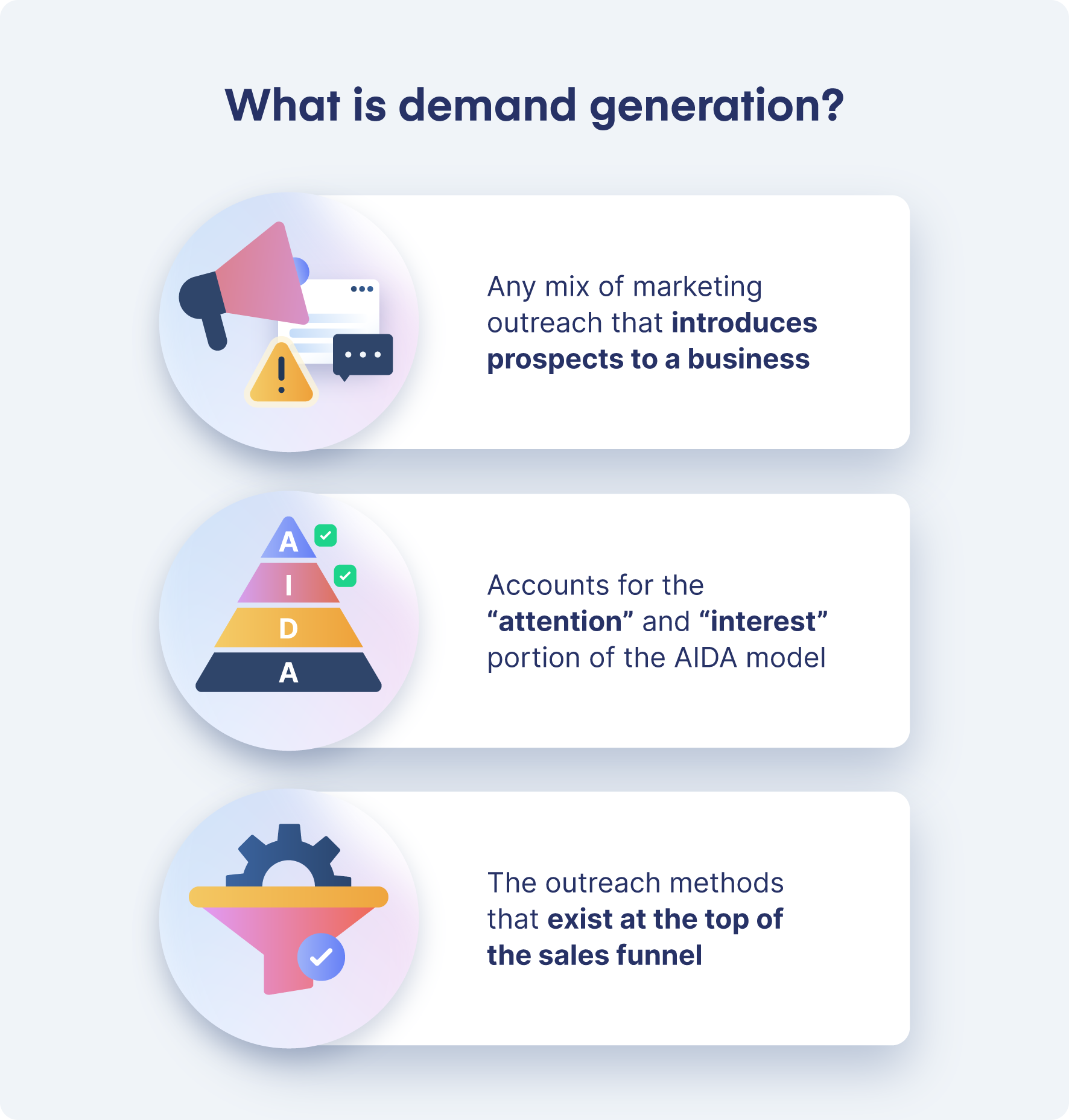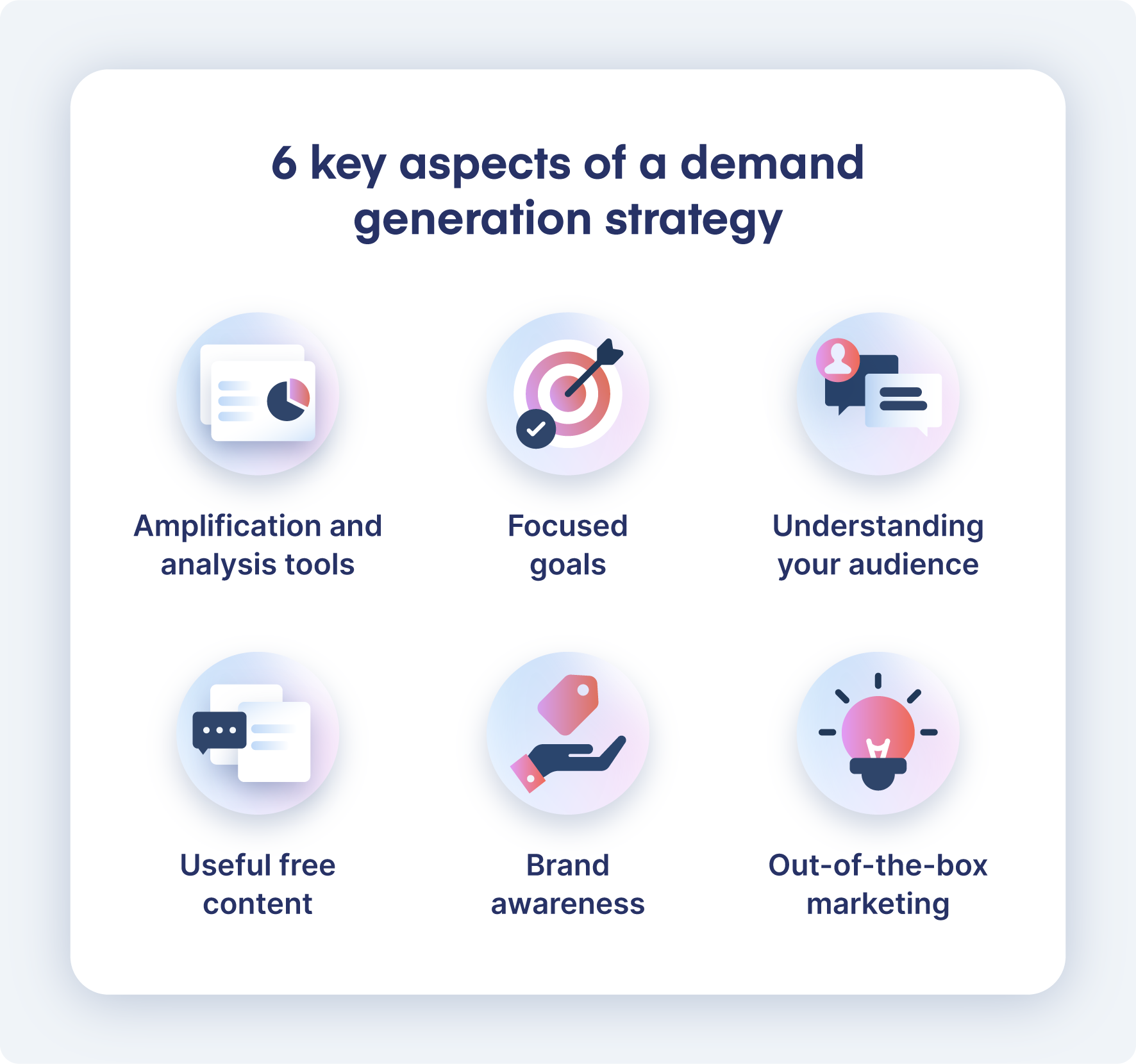What is demand generation? A guide to creating brand awareness
How did you find this article?
Did you type in “what is demand generation” into a search engine? Did you find it on social media? Maybe you found it while browsing our blog. Whatever led you here, know that this very article is an example of demand generation—and something that you can replicate in your outreach strategy.
Demand generation is any type of marketing that generates interest and attention in a brand. This can include content marketing, podcasts, eBooks, infographics, and anything else your ideal customer finds informative and engaging.
Unfortunately, successful demand generation efforts are often easier said than done. Many businesses miss the mark on their messaging by appealing to the wrong prospects, creating the wrong content, or selling when they should be informing. That’s where we come in.
Keep reading our guide on demand generation to learn more about what it is, successful techniques you can implement into your strategy, and how Clearbit can make your outreach efforts that much more effective.
What is demand generation?
Demand generation is any mix of marketing outreach that generates attention and interest in a brand. This can include content marketing, paid advertising, webinars, eBooks, and any other content that provides prospects with useful and actionable information.
Ultimately, the goal of demand generation is to introduce prospects to your brand, establish yourself as a trusted authority, and move those prospects through the sales funnel—nurturing them until they become customers.
What is the role of demand generation?
The role of demand generation is to introduce prospects to your brand, build trust, and generate interest.
In fact, demand generation accounts for the “attention” and “interest” portion of the AIDA model, which stands for attention, interest, desire, and action—and it’s worth noting that the next step of marketing generation, lead generation, encompasses the “desire” and “action” portion of that model.
When conducting demand generation outreach, be mindful of the following criteria:
- Attention: In the attention stage, prospects are asking themselves, “What brand is this?” At this point, you have provided them with useful information, and they are naturally becoming interested in what your company has to offer. A great example of demand generation in the attention stage is content marketing.
- Interest: In the interest stage, prospects are saying to themselves, “I like this brand.” Your goal here is to provide persuasive and engaging content, ultimately holding the prospect’s attention to keep them moving along the sales funnel. A demand generation tactic in the interest stage is to create useful content with persuasive elements—things that will “hook” prospects into learning more.
To give further context of the process at large, demand generation efforts represent the outreach at the top of the sales funnel. The goal is to create quality, useful content that will generate name recognition, buzz, and interest around your brand—all of this focuses primarily on informing new prospects rather than selling to them.
If prospects are nurtured correctly, they will continue to move down the sales funnel and require lead generation efforts from your business.

6 key aspects of a demand generation strategy
Now that you know why demand generation is important, we will detail six key aspects to implement in your strategy moving forward.
1. Employ tools focused on amplification and analysis
A comprehensive tech stack lays the foundation for effective demand generation outreach.
With proper tools, you have the ability to monitor what outreach efforts are most effective, personalize your campaigns, scale your activities, amplify your efforts, and more. There’s truly no substitute in today’s market for an effective outreach platform.
At Clearbit, we help brands supercharge their demand generation efforts through:
- Ad targeting: Reach large, highly qualified audiences with personalized messaging.
- Conversion tracking: Convert qualified leads at scale while optimizing ad spend and performance.
- Intent-based outreach: Turn your website visitors into pipeline, leading to more rapid and effective outreach.
Your demand generation strategy is only as effective as the tools and data powering it. This concept is explored more by our Director of Demand Generation, Colin White, in an article about how Clearbit uses our Data Activation Platform to generate demand with confidence.
2. Set focused goals
What are you trying to achieve with demand generation?
For an effective campaign, you should set clear, specific goals that relate to increasing the visibility of your brand. Simply setting goals of “more customers” or “more website traffic” isn’t focused enough. Instead, hone in on measurable results, such as “increase website traffic by ten percent in two months” or “increase PPC conversion rate by fifteen percent by the end of the quarter.”
A few important demand generation metrics you can focus on for goal setting include:
- Website traffic: More traffic to your website means there are more prospects interested in your offering.
- Customer acquisition cost (CAC): This metric is the total cost for a business to gain a new customer. Ranging from marketing costs to employee salaries, prioritizing CAC can result in efficient outreach.
- Social engagement: How is your social media content being received? Measuring social engagement is a key aspect of a demand generation strategy, and keeping an eye on these metrics with analytical tools like Hootsuite can make a noticeable impact on overall brand engagement and visibility.
- Content performance: This metric includes the performance of all your content marketing efforts such as the articles on your website, videos, podcasts, and any other form of outreach your business produces.
- Brand sentiment: How is your brand being received by prospects and the public at large? You can get an idea by taking a look at social media engagement, business reviews, and any other source produced by the public.
Successful demand generation needs focused goals, and focusing on measurable results is the best way to find success.
3. Understand your audience
In order to produce content that resonates with your audience, you first need to understand them—and there’s no better way to do that than with an effective ideal customer profile (ICP).
An ICP is a snapshot or bio of your perfect fit customer, and should include as much information as possible about the ideal prospect, such as pain points, business model, company size, location, and more. Using this as a guide, businesses can create outreach content that converts more effectively.
Without developing a comprehensive ICP, a business may be speaking to the technological void when performing demand generation efforts. Time and resources may be spent on reaching out to prospects in an ineffective way, lowering conversion rates and plummeting ROI.
Comprehensive ICPs, however, act as a playbook for successful demand generation. When a business knows its audience through and through, it can produce quality, personalized content that is sure to resonate.

4. Create informative and useful free content
Making a plan for content creation will build the foundation for future brand awareness and authority.
While you should ultimately plan content that focuses on all stages of the sales funnel—top-of-the-funnel (ToFu) content, middle-of-the-funnel (MoFu) content, and bottom-of-the-funnel (BoFu) content—for demand generation purposes, you should primarily focus on ToFu content.
ToFu content raises awareness and generates interest for prospects who are unfamiliar with your brand. This content’s primary purpose is to teach, so there should be no pressure on the prospect to make a purchase.
Some great examples of ToFu content include:
- Articles and blog posts
- Informational social media posts
- Podcasts
- eBooks
- Infographics
Remember, the goal is not to sell in this stage, but to inform and position your brand as an authority to new prospects. Focus on industry-specific topics and solve any day-to-day pain points that your prospects experience—this will increase brand awareness and make them more receptive to your offering.
5. Build awareness
Every day your prospects may be inundated with outreach from competing companies, and your job when building brand awareness is to ensure that these prospects notice you instead of the competition.
However, building brand awareness is more than just getting prospects’ attention—you need to leave a positive lingering impression of your brand on your audience. This positions your brand at the forefront when the time comes for a prospect to make a buying decision.
A few ways you can achieve positive brand awareness include:
Have a clear brand identity
Before you do anything, you need to have a solid brand identity. Who are you? What is your purpose? How are you different from the competition? Establishing a strong identity will serve as a guide for outreach strategies.
Prioritize positive reviews
Customer reviews can share an unbiased viewpoint of your company, and it’s something many people value when making buying decisions. Prioritize gaining authentic, positive customer reviews to show social proof to prospects.
Establish a strong social media presence
Nowadays, nearly everyone is involved with social media in one way or another. Establishing a strong presence on the platform where your ideal customer spends their time is a key factor in staying top of mind.
Position yourself as an authority
People buy from those they trust. Position your business as an authority with informative and helpful industry-related content to show your prospects that you are the right company to do business with.
In today’s marketplace, every day is a battle to stand out from the competition, but maintaining positive brand awareness will ensure that new leads flow into your funnel on a consistent basis.
6. Explore brand-appropriate alternative marketing strategies
When all the bases have been covered with traditional outreach, it may be wise to engage in brand-appropriate alternative marketing strategies.
These types of out-of-the-box tactics can help enhance brand awareness by positioning your company where the competition isn’t. A few effective methods include:
Influencer marketing
Social proof is a powerful tool in marketing. If influencers in your niche are promoting your product, prospects will be more likely to look into your company.
Product placement
Getting your product in videos that your target audience watches can stimulate attention and interest—and you don’t need to spend thousands getting into the new Netflix series to do it. Look for lower-budget opportunities for product placement, such as relevant YouTube creators.
Guerilla marketing
Guerilla marketing is regarded as an unconventional yet highly effective way to market your brand. Think of creative tactics to boost awareness—Burger King, for example, staged a breakup on their social media post to spark buzz and attention.
Branded entertainment
If appropriate for your industry, exploring forms of branded entertainment can garner serious attention for your company. A perfect example of this is Lego, which recently produced films and video games based on its building block brand.
The end goal of demand generation is to expand brand awareness and prospect interest, and alternative marketing strategies are a great way to gain an additional edge in the marketplace.
Clearbit can aid in demand generation
Demand generation is a key strategy to attract new prospects and get them interested in your business. For a company to achieve this successfully, it not only needs to focus on the right content, but the right customers as well.
From intent-based outreach to ad targeting and more, Clearbit has the solutions you need to run successful demand generation campaigns.

